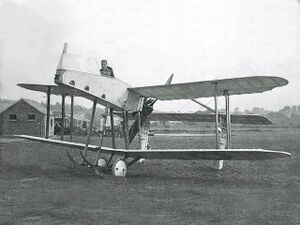Engineering:AD Scout
| Scout | |
|---|---|

| |
| Role | Fighter |
| Manufacturer | Air Department |
| Designer | Harris Booth[1] |
| First flight | 1915 |
| Primary user | Royal Naval Air Service - testing only |
| Number built | 4[1] |
The AD Scout (also known as the Sparrow) was designed by Harris Booth of the British Admiralty's Air Department as a fighter aircraft to defend Britain from Zeppelin bombers during World War I.[1]
Design and development
The Scout was a very unconventional aircraft – a biplane with a fuselage pod mounted on the upper wing. A twin-rudder tail was attached by four booms, and it was provided with an extremely narrow-track undercarriage. The primary armament was intended to be a 2-pounder recoilless Davis Gun, but this was never fitted.[1] Four prototypes were ordered in 1915, and two each were built by Hewlett & Blondeau and the Blackburn Aeroplane & Motor Company.
Operational history
Trials flown by pilots of the Royal Naval Air Service at Chingford proved the aircraft to be seriously overweight, fragile, sluggish, and difficult to handle, even on the ground. The project was abandoned, and all four prototypes were scrapped.[1]
Operators
 United Kingdom
United Kingdom
- Royal Naval Air Service
Specifications (AD Scout)
Data from The British Fighter since 1912[2]
General characteristics
- Crew: 1
- Length: 22 ft 9 in (6.93 m)
- Wingspan: 33 ft 5 in (10.19 m)
- Height: 10 ft 3 in (3.12 m)
- Powerplant: 1 × Gnome Monosoupape 9 Type B-2 9-cylinder air-cooled rotary piston engine, 100 hp (75 kW) [3]
- Propellers: 2-bladed fixed-pitch propeller
Performance
- Maximum speed: 84 mph (135 km/h, 73 kn) [4]
- Range: 210 mi (340 km, 180 nmi)
Armament
- Guns: 1x 2-pounder (40 mm) Davis recoilless gun (intended, but never fitted in view of the fragility of the Scout's construction)
References
- Notes
- ↑ 1.0 1.1 1.2 1.3 1.4 Jackson, Aubrey Joseph (16 March 1989). Blackburn Aircraft since 1909 (1st ed.). London: Putnam & Company Ltd.. pp. 98–101. ISBN 0-85177-830-5.
- ↑ *Mason, Francis K. (1992). The British Fighter since 1912. Annapolis, USA: Putnam & Company Ltd.. p. 42. ISBN 1-55750-082-7.
- ↑ Bruce, J.M. (1965). War Planes of the First World War: Volume One Fighters. London: Macdonald. p. 5.
- ↑ *Lewis, Peter (1979). The British Fighter since 1912 (4th ed.). London: Putnam & Company Ltd.. pp. 392–393. ISBN 0-370-10049-2.
 |

